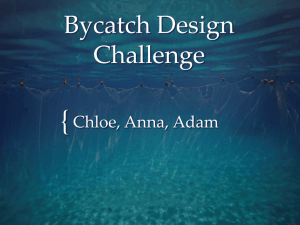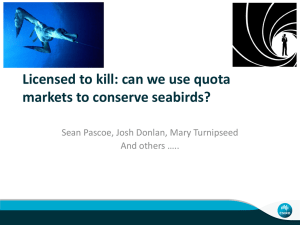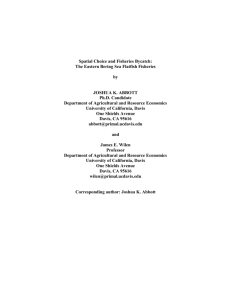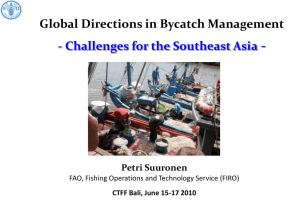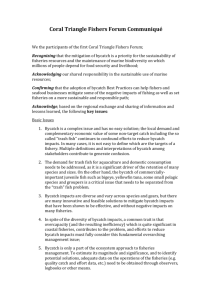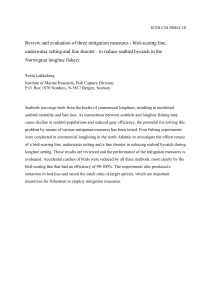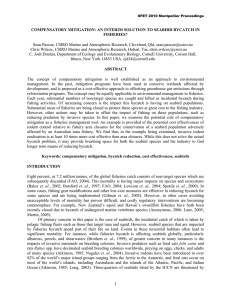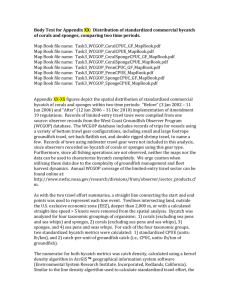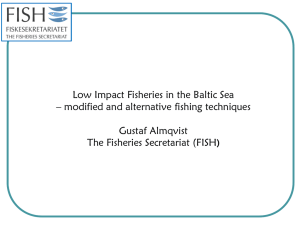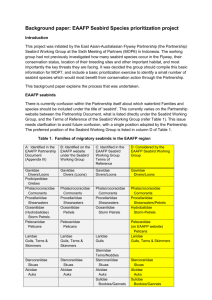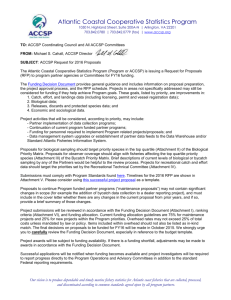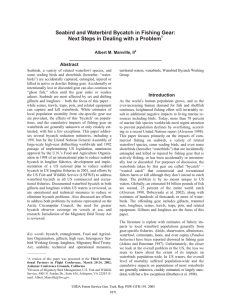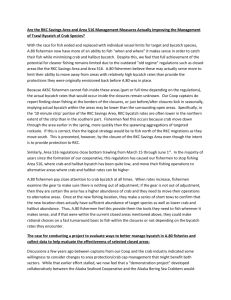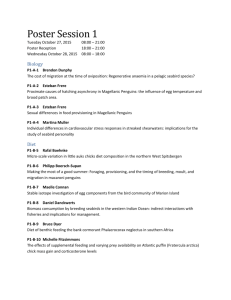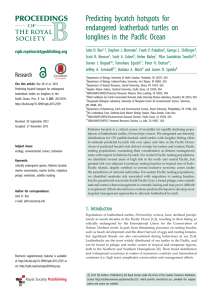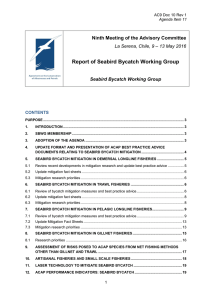Incidental Catches of Seabirds Report of workshop 16 May 2013
advertisement
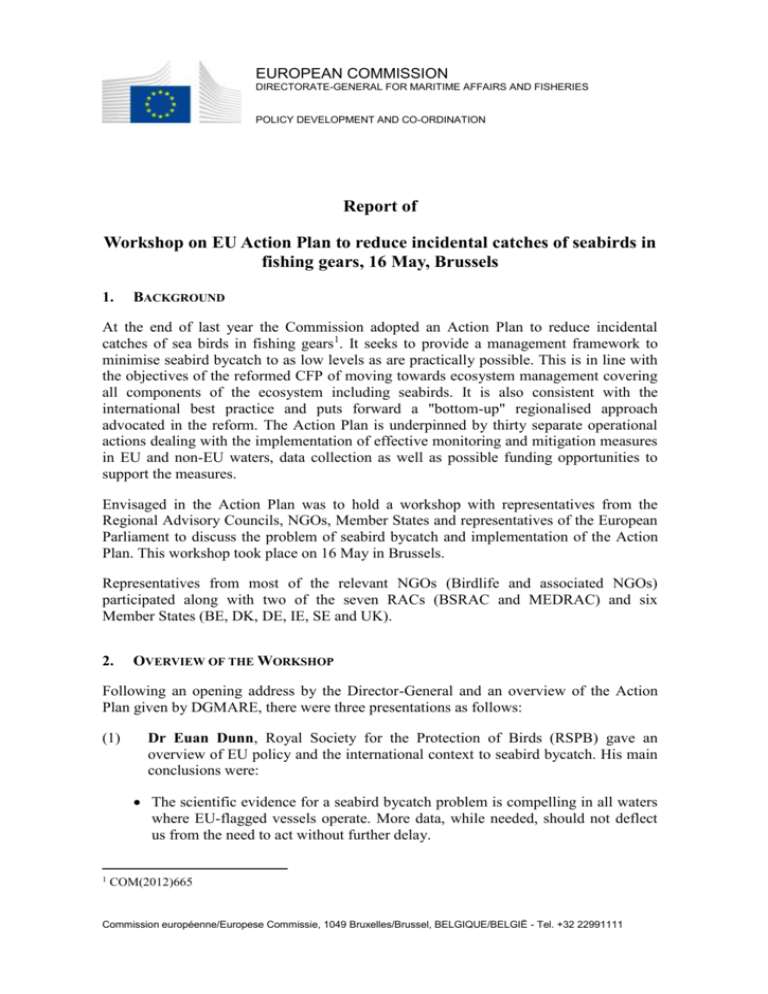
EUROPEAN COMMISSION DIRECTORATE-GENERAL FOR MARITIME AFFAIRS AND FISHERIES POLICY DEVELOPMENT AND CO-ORDINATION Report of Workshop on EU Action Plan to reduce incidental catches of seabirds in fishing gears, 16 May, Brussels 1. BACKGROUND At the end of last year the Commission adopted an Action Plan to reduce incidental catches of sea birds in fishing gears1. It seeks to provide a management framework to minimise seabird bycatch to as low levels as are practically possible. This is in line with the objectives of the reformed CFP of moving towards ecosystem management covering all components of the ecosystem including seabirds. It is also consistent with the international best practice and puts forward a "bottom-up" regionalised approach advocated in the reform. The Action Plan is underpinned by thirty separate operational actions dealing with the implementation of effective monitoring and mitigation measures in EU and non-EU waters, data collection as well as possible funding opportunities to support the measures. Envisaged in the Action Plan was to hold a workshop with representatives from the Regional Advisory Councils, NGOs, Member States and representatives of the European Parliament to discuss the problem of seabird bycatch and implementation of the Action Plan. This workshop took place on 16 May in Brussels. Representatives from most of the relevant NGOs (Birdlife and associated NGOs) participated along with two of the seven RACs (BSRAC and MEDRAC) and six Member States (BE, DK, DE, IE, SE and UK). 2. OVERVIEW OF THE WORKSHOP Following an opening address by the Director-General and an overview of the Action Plan given by DGMARE, there were three presentations as follows: (1) Dr Euan Dunn, Royal Society for the Protection of Birds (RSPB) gave an overview of EU policy and the international context to seabird bycatch. His main conclusions were: The scientific evidence for a seabird bycatch problem is compelling in all waters where EU-flagged vessels operate. More data, while needed, should not deflect us from the need to act without further delay. 1 COM(2012)665 Commission européenne/Europese Commissie, 1049 Bruxelles/Brussel, BELGIQUE/BELGIË - Tel. +32 22991111 In EU waters, legislation is needed to underpin an essentially voluntary Action Plan to ensure it minimises seabird bycatch. Several developing nations have accepted the need for action, accepting this is a highly solvable problem, and have hard-wired measures and protocols into national regulations. Awareness-raising with – and hands-on working with – fishermen is key. The EU has been proactive in securing RFMO measures to reduce seabird bycatch but has a continuing role to push for (e.g.) strengthening compliance and reporting requirements. (2) Pep Arcos, SEO/BirdLife, gave an overview of seabird bycatch in EU waters. His main conclusions were: Information on bycatch is still scattered, as there are no systematic monitoring programmes. In particular there is limited information on fishing effort, especially small scale that makes it difficult to assess the extent of the problem. There is a lack of sound studies relating bycatch and population trends There is only limited work on mitigation measures in EU waters compared to internationally. For some gears in EU waters there are ready made solutions to mitigate against the problem but for others there is a need to develop mitigation measures i.e. gillnets (3) Svein Lokkeborg, Institute of Marine Research, Bergen, who conducted a review of seabird bycatch mitigation methods for trawl, longlines and gillnets for the FAO gave an overview of available mitigation measures for reducing seabird bycatch: His main conclusions were: Efficient measures have to be designed specifically for each fishery (no single solution). For longline fisheries simple solutions such as streamer lines, weighted lines and night setting are effective, while for trawl fisheries, streamer line and strategic offal management are also proven to reduce bycatch in fisheries in international waters. For gillnet and purse seine fisheries no effective measures are currently available other than spatial/temporal closures which are unpopular with fishermen. Following these presentations, Michael Andersen (BSRAC) and Federica Barbera (MED RAC) made interventions on behalf of their respective RACs although the representative of the MEDRAC stressed that the MEDRAC had not formed a formal opinion on Action Plan. The main comments from the RACs were as follows: This is a bio-diversity issue where the industry, on the whole, accepts there is a problem that needs to be addressed. This is a "win-win" situation given the majority of the industry does not see measures necessarily as a threat. 2 It seems a ready-made issue to be addressed through Industry/Science Partnership projects. The Action Plan is balanced and the approach by which top-down legislation is limited is welcomed. However, it is important to establish a "level playing field" so that actions taken are not restricted to a limited number of Member States. The industry can help with data collection but scientists must show a willingness to utilise this data and not reject it as unreliable as has been the case in the past. We need research to develop solutions for gillnet fisheries. Resorting simply to closing areas in the absence of effective mitigation measures is not a solution and will not lead to industry buy-in. The impacts of bycatch on seabird populations must be seen in context with other forms of mortality including hunting, disease and predation by animals such as rats. 3. MAIN CONCLUSIONS Following the presentations there was a general discussion around a number of central issues (e.g. data collection, research, the need for regulatory measures, certification as a driver for measures Based on this discussion and the presentations, the main conclusions from the workshop can be summarised as follows: (1) Awareness of bycatch issues related to sensitive species such as seabirds and cetaceans needs to be raised. From the Commission's perspective we must ensure that when developing a new technical measures framework and multiannual plans in the future that we include measures to address bycatch issues in the context of the ecosystem approach. (2) Efforts should be concentrated in "hotspots" or problem fisheries where bycatch is known to be a particular problem. We should learn from the example of CCALMR where complying with ecosystem measures including measures to protect seabirds are a pre-requisite for obtaining a licence to fish. (3) The Commission is of the opinion that data collection on bycatch of seabirds and other sensitive species should be included under the DCMAP but if due to a lack of political will to do so then alternatives forms of data collection for such bycatch issues must be found. (4) Access to funding was highlighted by the NGOs as a particular problem. Therefore DGMARE committed to work actively with DG RTD (FP7 and Horizon 2020) and also Member States through the EMFF to instigate research particularly into the area of mitigation of sensitive of bycatch of sensitive species. 3 (5) The Commission intends to review the monitoring and mitigation measures to protect seabirds in RFMOs and will continue to highlight this issue with RFMOs. (6) Given only two of the RACs were represented, the Commission intends to follow-up this issue with the RACs to raise awareness and buy-in with the Action Plan. 4
